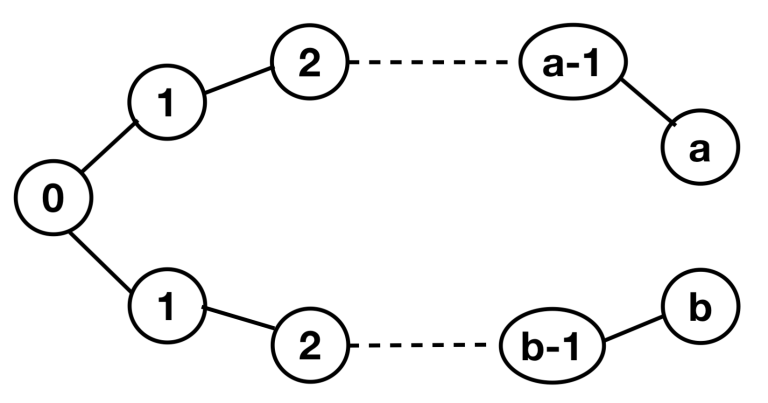Hello, Codeforces! For many of us, the A + B problem was the first one we've solved and we think of it as just a really easy problem. But what if I told you there is a way to flex your programming skills by solving this problem with style? On this wonderful day of March 32nd, I will present a few ways to solve this interesting problem. I will only consider a and b strictly larger than 0.
Noob approach
std::cout << a + b;
Almost-noob approach
Notice that we can interpret a + b as a incrementing a number a times, then b times. We get:
int ans = 0;
for (int i = 1; i <= a; i++) ans++;
for (int i = 1; i <= b; i++) ans++;
std::cout << ans;
Slightly clever approach
Of course, we cannot stop there. A wise man once said: "every competitive programming problem is a dynamic programming problem if you try hard enough". So... let's be a little bit more imaginative! We define dp[i][j] as the result you get if you increment a number i times, then j times. So the final result will be dp[a][b] and the recurrence relation is:
dp[i][j] = 1 + max(dp[i-1][j], dp[i][j-1]), for all i <= a and j <= b.
(the max function is, of course, for aesthetic purposes)
Good programmer approach
Some competitive programming problems require you to transform the task given in the statement into something more manageable and perhaps easier to visualise... what better way to visualise a problem than use graphs! We construct a graph and relabel its nodes like this:

We can see that a + b is in fact equal to the distance between the node labeled a in the upper part and the node labeled b in the lower part. You can now use your favourite graph-traversal algorithm to solve this problem.
What separates good programmers from LEGENDARY programmers
A programming challenge isn't just about algorithms; it can also be about the programming language you use! Of course, if you want to do it the boring way, sure, use C++, Java or Python... However, if you want something more interesting, I will present to you the best programming language in the world: Brainfuck!
Yep, that really exists. Brainfuck is a very minimalist and easy to learn language. In fact, it only has 8 commands: ><+-.,[]. Who needs user-defined functions and comparators and classes that always create bugs, when you've got Brainfuck! For example, this is a "Hello World!" program in this wonderful language:
++++++++[>++++[>++>+++>+++>+<<<<-]>+>+>->>+[<]<-]>>.>---.+++++++..+++.>>.<-.<.+++.------.--------.>>+.>++.
That's really it: no clunky and buggy functions and IO stuff. Considering the modern trend of simplifying everything (for example, logos and UIs), sooner or later, the world will throw away C++, Python and Java and use a simplist language, like Brainfuck. Legendary programmers already use this language of the future and solve all competitive programming problems in Brainfuck.
As I just said, Brainfuck is a very easy to learn language. In fact, the implementation of the graph approach to the A + B problem is so elementary, that it is left as an exercise for the reader.











as a legendary programmer, I agree that Brainfuck is the best programming language in the world
I think brainfuck is the best language in the whole space!
Totally agree!
How about the Secret 2021 language ?
If you don't wanna learn a new programming language like brainfuck and already know some javascript, but still wanna use a minimalistic programming style, then you must definitely try JSFuck. For example, this is a "Hello World!" program.
Looks amazing, I love it
Yeah it's amazing
And non-hackable too
It's geniunely impressive, I actually didn't know you can submit Brainfuck-like code on Codeforces
LoL, I thought he was joking about Brainfuck.
For the first time in history,a programming language's name actually makes sense.
This is yet another reason to switch to Brainfuck
Lol, i remember once trying to figure out the number of numbers between L,R in brainfuck as part of a contest. I struggled for an hour for the edge case when L was equal to R.
In search of Gold : C++ , Java, Python
We found a Diamond : Brainfuck!!
I tried a novel solution. First, sleep for A milliseconds, then sleep for B milliseconds, then measure how much time passed since the start. Unfortunately, there a few problems with this approach. Firstly, in the worst case of A = B = 1000, this will take 2 seconds and TLE. Secondly, A and B can be negative, so it only works on programming languages with built-in support for time travel. Another issue is that there isn't a good enough way to measure time without serious precision error. I wish competitive programming was friendlier to clock-based algorithms.
Indeed, clock-based algorithms are really underrated. Fortunately, rumours say that the future C++23 standard will fully support time travel and have predefined functions that solve all the time travelling paradoxes in linear time
I'm looking forward to solving watermelon with Hitler.
Real programmers wait for the contest to end, read the editorial and then write a code which time travels back to submit itself.
And of course there's a Haskell technique to do that.
This blog made me click on the upvote button multiple times hoping it would work
That’s awesome